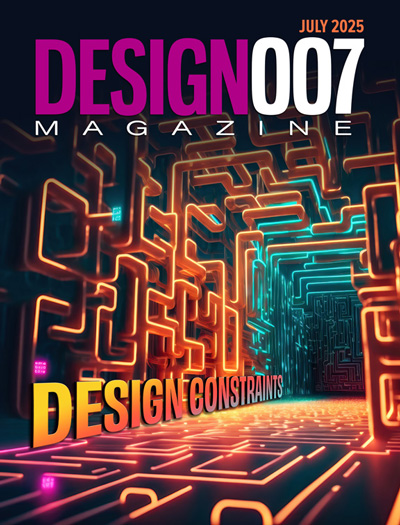-

- News
- Books
Featured Books
- design007 Magazine
Latest Issues
Current Issue
Signal Integrity
If you don’t have signal integrity problems now, you will eventually. This month, our expert contributors share a variety of SI techniques that can help designers avoid ground bounce, crosstalk, parasitic issues, and much more.

Proper Floor Planning
Floor planning decisions can make or break performance, manufacturability, and timelines. This month’s contributors weigh in with their best practices for proper floor planning and specific strategies to get it right.

Showing Some Constraint
A strong design constraint strategy carefully balances a wide range of electrical and manufacturing trade-offs. This month, we explore the key requirements, common challenges, and best practices behind building an effective constraint strategy.
- Articles
- Columns
- Links
- Media kit
||| MENU - design007 Magazine
AltiumLive Munich: Day 1 Keynotes
January 28, 2019 | Pete Starkey, I-Connect007Estimated reading time: 15 minutes
The afternoon session of the first day of AltiumLive commenced with a keynote presentation from Alun Morgan, technology ambassador with Ventec International Group, entitled “PCB Base Material Properties and Developments: What Designers Need to Know.” It was another full house, and those attending were keen to benefit from his encyclopaedic knowledge and outstanding teaching skills.
Morgan made it clear that the base material was fundamental to the electrical, mechanical, and thermal performance of every PCB. But how many PCB designers really understood its significance, characteristics, benefits, limitations, and how to choose and specify an appropriate material for a particular application?
From the most basic of first principles to the latest developments in low-loss laminates for high-speed applications and thermally conductive laminates for heat management, he covered a broad spectrum in a plain language. “All you ever needed to know about laminates but were afraid to ask.” He covered a compendium of the technology distilled to emphasise information of particular relevance to designers and dispelled a lot of myths and mysteries along the way. Even the most knowledgeable designers could learn a lot from this presentation.
In its generally accepted sense, a base laminate comprised an insulating material—usually a composite of a resin and a reinforcement—with a conductor bonded to one or both sides. Morgan discussed PCB base material resin types and reinforcements and resin/reinforcement selection considerations; there are so many combinations and permutations. He also addressed electrical considerations such as dielectric constant, dissipation factor, dielectric breakdown strength, passive intermodulation, surface and volume resistivity, and comparative tracking index.
Mechanical considerations highlighted included processability in terms of drilling, punching, and laminating; flexural and tensile strength; coefficient of thermal expansion; thermal conductivity; thermal cycling resistance; thermal endurance; maximum operating temperature; water absorption; dimensional stability; flammability; glass transition temperature; decomposition temperature; and foil peel strength. Lastly, Morgan explained the cost considerations of specifying the appropriate material for a particular design and the difference between thermoplastic and thermoset resins. Thermoplastic resins melt on heating and re-solidify on cooling while thermoset resins—epoxy being the familiar example—harden permanently on heating.
In a schematic representation of the typical process stages for manufacturing a glass-epoxy laminate, he demonstrated how glass fabric was taken from the roll and impregnated with a solution of uncured epoxy resin, then passed through a vertical oven to remove the solvent and partially cure the resin to form a prepreg, which was then cut into sheets. The required number of plies of prepreg was then laid between sheets of copper foil in stainless-steel press-plates and placed in a heated press to cause the resin to flow, gel, and harden to produce a finished laminate.
Resisting the temptation to delve too deeply into chemical theory, Morgan discussed the basic chemistry of epoxy resins, describing how they were manufactured and the mechanism of the crosslinking process with dicyandiamide and phenolic curing agents. Flame retardancy had been a long-standing safety issue, and he explained the differences between traditional brominated flame retardants and the phosphorus-based alternatives developed to satisfy the demand for halogen-free materials.
Further, he discussed the significance of glass transition temperatures, how they were influenced by the curing chemistry of the resin, how different measurement methods could give different results, and how thermal expansion coefficients were influenced by glass transition temperature and could be reduced by the use of fillers.
Morgan also covered the glass fibre manufacturing and the weaving of different styles of glass fabric. Due to differences in dielectric constant between glass and resin, the effects that the weave texture of the fabric could have on signal integrity in controlled impedance designs could be partly mitigated using square-weave and spread-glass fabrics. On the theme of high-speed design, he also introduced the concept of the impedance triangle, demonstrating that for an equivalent dissipation factor, a lower dielectric constant enabled larger trace geometries for improved manufacturing yield.
Morgan discussed conduction and dielectric losses, explaining that conduction losses were primarily resistive losses in the conductor layers and leakage of charge through the dielectric, while dielectric losses resulted from the alternating electric field causing movement of the material’s molecular structure generating heat, which increased with increasing frequency. Dielectrics were insulators because they had few free electrons available to carry electrical current. When subjected to an electric field, polarisation occurred whereby positive and negative charges were displaced relative to the electric field. This polarisation reduced the electric field in the dielectric, causing part of the applied field to be lost. High-speed designs had driven the development low-loss laminates whereas standard FR-4 typically had a loss tangent greater than 0.015 and special-purpose materials were currently available with a loss tangent less than 0.005.
It was essential that the copper foil that formed conductor layers was securely bonded to the base laminate so that etched tracks would exhibit adequate peel strength. The foil was manufactured by electrodeposition, and as part of the process, the bonding surface was given a roughening treatment to optimise adhesion of the resin during the laminating process. Morgan explained that as frequency increased, the signal was not carried within the conductor cross-section, but predominantly in the surface as a result of a phenomenon called the skin effect. The roughness of the foil could cause problems with signal integrity, and for high-frequency applications, special grades of low-profile, very-low-profile, and ultra-low-profile foil were available.
He concluded his presentation with an introduction to the technology of thermally conductive laminates used to keep heat-generating components cooler and reduce system costs by reducing the requirement for heat sinks and cooling fans. Typical applications were the thermal management of LEDs and embedded components. These laminates consisted of a copper foil bonded to an aluminium base via a thin reinforced—or non-reinforced—thermally conductive dielectric and offered the benefits of straightforward PCB fabrication and assembly using standard equipment. Thermal conductivity was measured in watts per metre Kelvin, and materials were already available with values from 1.0–7.0 W/mK, with 10 W/mK in development.
Morgan shared an enormous amount of knowledge with this comprehensive introduction to printed circuit base materials and especially gave an insight into the effects of material characteristics on signal integrity. He may not have used exactly the same terminology and analogy as Dan Beeker, but the two presentations nicely complemented each other as learning experiences for electronics engineers, adding breadth and depth to their understanding of the physical and practical realities of the PCBs they could create with their design automation tools.
Conclusion
The AltiumLive team should be congratulated on pulling together an impressive programme and attracting such an attentive audience for their eminent keynote presenters. Here, I have reviewed only part of the proceedings of the first of two intense conference days. Besides these keynotes, there was a wide-ranging agenda of technical user presentations and professional breakout sessions, which I will report separately.
Visit I-007eBooks to download your copy of Altium micro eBook today:
The Printed Circuit Designer's Guide to...Design for Manufacturing (DFM)
Testimonial
"Our marketing partnership with I-Connect007 is already delivering. Just a day after our press release went live, we received a direct inquiry about our updated products!"
Rachael Temple - AlltematedSuggested Items
Trouble in Your Tank: Implementing Direct Metallization in Advanced Substrate Packaging
09/15/2025 | Michael Carano -- Column: Trouble in Your TankDirect metallization systems based on conductive graphite are gaining popularity throughout the world. The environmental and productivity gains achievable with this process are outstanding. Direct metallization reduces the costs of compliance, waste treatment, and legal issues related to chemical exposure. A graphite-based direct plate system has been devised to address these needs.
Closing the Loop on PCB Etching Waste
09/09/2025 | Shawn Stone, IECAs the PCB industry continues its push toward greener, more cost-efficient operations, Sigma Engineering’s Mecer System offers a comprehensive solution to two of the industry’s most persistent pain points: etchant consumption and rinse water waste. Designed as a modular, fully automated platform, the Mecer System regenerates spent copper etchants—both alkaline and acidic—and simultaneously recycles rinse water, transforming a traditionally linear chemical process into a closed-loop system.
Driving Innovation: Depth Routing Processes—Achieving Unparalleled Precision in Complex PCBs
09/08/2025 | Kurt Palmer -- Column: Driving InnovationIn PCB manufacturing, the demand for increasingly complex and miniaturized designs continually pushes the boundaries of traditional fabrication methods, including depth routing. Success in these applications demands not only on robust machinery but also sophisticated control functions. PCB manufacturers rely on advanced machine features and process methodologies to meet their precise depth routing goals. Here, I’ll explore some crucial functions that empower manufacturers to master complex depth routing challenges.
Trouble in Your Tank: Minimizing Small-via Defects for High-reliability PCBs
08/27/2025 | Michael Carano -- Column: Trouble in Your TankTo quote the comedian Stephen Wright, “If at first you don’t succeed, then skydiving is not for you.” That can be the battle cry when you find that only small-diameter vias are exhibiting voids. Why are small holes more prone to voids than larger vias when processed through electroless copper? There are several reasons.
The Government Circuit: Navigating New Trade Headwinds and New Partnerships
08/25/2025 | Chris Mitchell -- Column: The Government CircuitAs global trade winds continue to howl, the electronics manufacturing industry finds itself at a critical juncture. After months of warnings, the U.S. Government has implemented a broad array of tariff increases, with fresh duties hitting copper-based products, semiconductors, and imports from many nations. On the positive side, tentative trade agreements with Europe, China, Japan, and other nations are providing at least some clarity and counterbalance.


